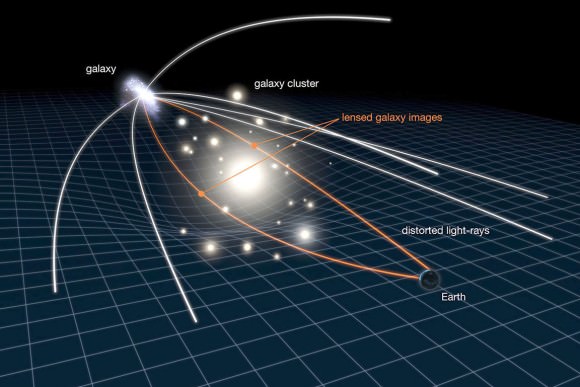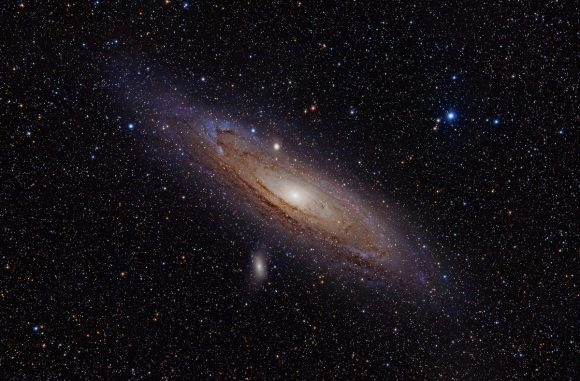Stephen Hawking’s theory on tiny black holes as the source of dark matter does not hold true anymore.
An international team of scientists has proved wrong to the late and great Stephen Hawking’s theory on primordial black holes and dark matter by putting his theory to its “most rigorous test to date”.
The research team led by Hiroko Niikura, a PhD candidate student from the Kavli Institute for the Physics and Mathematics of the Universe (IPMU) including astronomers from Japan, India and the US, confirmed this news in their research paper which was published in the journal Nature Astronomy on April 1.
Researchers used the gravitational lensing effect to look for primordial black holes between Earth and the Andromeda galaxy.
Of the 11 authors of the published research paper, two are from India [from Inter–University Centre for Astronomy and Astrophysics (IUCAA), Pune], one from the US and the rest from Japan. The research idea came from Masahiro Takada, one of the authors from Japan.
Incidentally, the paper titled, ‘Microlensing constraints on black holes with Subaru/HSC Andromeda observations’, was reviewed by Bernard Carr, who wrote the 1974 paper (which has been challenged) along with Hawking.
Table of Contents
What is Dark Matter?
It’s a bit ironic that we can’t detect, much less see, most of what we call the “Observable Universe”. Among the long-standing mysteries in physics and astronomy is dark matter that’s been puzzling astronomers for decades.
“About 85% of the total mass of the universe is unknown to humankind and is predicted to be made of a hypothetical form of matter known as Dark Matter.” Thus, stars, galaxies, and atoms that we see all around are just the tip of the iceberg and the elusive dark matter makes up the bulk of the Universe.
Why Dark Matter is called dark?
Dark matter is referred ‘dark’ because it does not appear to interact with observable electromagnetic radiation, such as light, and is thus invisible to the entire electromagnetic spectrum, making it extremely difficult to detect using usual astronomical equipment.
Why Dark Matter is called matter?
The dark matter is considered to be a ‘matter’ since it appears to have a gravitational attraction. This gravitational force of attraction prevents stars in our Milky Way galaxy from flying apart.
Evidence for Dark Matter
In the Solar System, Mercury – the innermost planet – takes just 88 earth days (87.97 days) to complete one revolution around the Sun. Neptune – the outermost planet – takes 60,182 earth days for the same journey. Likewise, the laws of gravity expect us to see stars closer to the centre of a galaxy go around faster than stars at the edge. However, in most galaxies, both the innermost & the outermost stars take almost the same time to complete one revolution – an observation first made by Vera Rubin in the 1970s.
It was as if some invisible material, now known as dark matter, enveloped the galaxies, giving an extra push to the outer stars and accelerating them. The nature of this material has been a mystery since the 1930s when Fritz Zwicky first proposed its existence.
Discovery of Dark Matter
Attempts to detect dark matter particles using underground experiments, or accelerator experiments including the world’s largest accelerator, the Large Hadron Collider, have failed so far.
While dark matter’s large-scale effects on the fabric of space-time are salient, one of the burning questions is its origin. Where could it come from?
Stephen Hawking’s theory was that tiny black holes formed early in the universe could make up dark matter. Such primordial black holes are not formed from dying stars; they are predicted to have originated a few seconds after the Big Bang. Highly dense regions in the early universe could collapse onto themselves to form black holes.
What is Dark Matter Composed of?
Cosmologists have come up with various theories and hypotheses to explain the dark matter. Some postulate it to be composed of neutrinos, which are particles that have no charge but have a tiny mass and, therefore, do not have interaction with the electromagnetic spectrum, but are gravitationally interacting. Some others have postulated they may be some new kind of elementary particles – `weakly-interacting massive particles (WIMPs)’, or `gravitationally-interacting massive particles’ (GIMPs), which are yet to be detected.
Breakthrough
When the big bang was proposed (which is now widely accepted as the hypothesis on the origin of the universe), the two Soviet physicists, Yakov Borisovich Zel’dovich and Igor Dmitriyevich Novikov, showed that at the initial instant of the big bang, the densities would have been very high at many points, giving rise to the formation of small black holes. They were named primordial black holes.
Stephen Hawking investigated primordial black holes in 1971 (Stephen Hawking’s theory). He calculated that the mass of the primordial black holes (PBHs) could range from as low as one-hundredth of a milligram to as high as more than the mass of a thousand Suns.
Gravitational Lensing
Black holes are not radiant and will not be visible through any telescope.
Gravitational lensing, an effect first suggested by Albert Einstein, manifests itself as the bending of light rays coming from a distant object such as a star due to the gravitational effect of an intervening massive object such as a primordial black hole.

Illustration showing working of gravitational lensing. The gravity of a large galaxy cluster is very strong, it bends, brightens and distorts the light of distant galaxies behind it. Image Credit: NASA, ESA, L. Calcada
In extreme cases, such light bending causes the background star to appear much brighter than it originally is.
Rare Event of Gravitational Lensing
However, gravitational lensing effects are very rare events because it requires a star in the galaxy, basically a primordial black hole, acting as the gravitational lens, and an observer on Earth to be exactly in alignment with one another. When the black hole is in line with a distant star, due to gravitational attraction, light rays are bent inwards like a lens, making the star appear brighter.
The Experiment
The scientists tested this theory by using the famous Subaru Telescope at the Mauna Kea Observatory in Hawaii to observe the neighboring Andromeda Galaxy, which is located about 2.54 million light-years away. Unlike most galaxies in our cosmic neighborhood, Andromeda is one of only 100 or so that is approaching our galaxy – at a rate of 110 km per second (68 miles per second) – and is destined to collide with it.

Andromeda Galaxy. Image Credit: Wikipedia Commons/Adam Evans
In order to maximize the chances of capturing an event, the researchers used the Hyper Suprime-Cam digital camera on the Subaru telescope which can capture the whole image of the Andromeda galaxy in just one shot.
Taking into account how fast primordial black holes are expected to move in interstellar space, the team took multiple images to be able to detect the flicker of a star as it brightens for a period of a few minutes to hours due to gravitational lensing.
From 190 consecutive images of the Andromeda galaxy taken over seven hours during one clear night, the team scoured the data for potential gravitational lensing events.

The Subaru Telescope in Hawaii. Credit: Denys/Wikimedia Commons, CC BY 3.0
Observations
If dark matter consists of primordial black holes of a given mass, in this case, masses lighter than the Moon, the researchers expected to find about 1,000 events.
However, after careful analyses, they could only identify one case.
Result
The team’s results showed primordial black holes can contribute no more than 0.1 percent of all dark matter mass. Therefore, it is unlikely the theory is true.
Conclusion
These results show that Stephen Hawking’s theory wasn’t entirely wrong about dark matter’s nature. Now at least we know what 0.1 % of dark matter is, or a tiny part of the mystery finally elucidated. Astrophysicists now have to figure out what makes up the remaining 99.99 % of dark matter.
They are also planning to further develop their analysis of the Andromeda galaxy. One new theory researchers will investigate is to find whether binary black holes discovered by gravitational wave detector LIGO are in fact primordial black holes.
You may also like to read –
- “Homo luzonensis” – New species of ancient human discovered
- “Chain-melted state” – A new state of matter discovered
- First Ever REAL Black Hole Image
- World’s first country to launch 5G mobile services
- West Nile Virus
We hope this article helped you gain insight into Dark Matter and its recent developments. You may also want to check out other articles like this. If you liked the article and want to be notified for the next post, then please subscribe to the notifications by clicking on ‘allow’ tab on the pop-up or by pressing the red bell icon on the bottom right side. You can also follow us on Twitter and Facebook for the latest updates.



5 Comments
Ayi Woro · April 14, 2019 at 1:25 pm
This is really an informative article on Dark Matter.
Lenkdrachenfeuer · April 14, 2019 at 5:05 pm
I discovered your blog site on google and check a few of your early posts. Continue to keep up the very good operate. I just added up your RSS feed to my MSN News Reader. Seeking forward to reading more from you later on.
Trish Goff · April 18, 2019 at 6:40 pm
You have clearly explained the primordial black holes and dark matter.
Osen · April 20, 2019 at 9:51 pm
Hey There. I found your blog using MSN. This is a really well-written article. I’ll be sure to bookmark it and return to read more of your useful info. Thanks for the post. I will definitely comeback.
Eastham · April 21, 2019 at 11:36 am
Hello my friend! I want to say that this article is amazing, nice written and include almost all important infos. I’d like to see more posts like this.